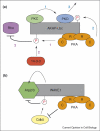A-kinase anchoring proteins take shape
- PMID: 17317140
- PMCID: PMC3521038
- DOI: 10.1016/j.ceb.2007.02.011
A-kinase anchoring proteins take shape
Abstract
A-kinase anchoring proteins (AKAPs) are signaling scaffolds that contribute to various aspects of cAMP signaling. They do this by tethering protein kinase-A to specific subcellular sites, thereby focusing its activity toward relevant substrates. Recently the structural basis for these protein-protein interactions has been elucidated by x-ray crystallography. Recent reports have identified AKAPs that bind to adenylyl cyclases to regulate cAMP synthesis and that sequester phosphodiesterases to break down this second messenger locally. Another emerging aspect of AKAP function is their role in integrating cAMP signaling with other signaling pathways. For example, molecular and genetic approaches have been used to show that the neuronal anchoring protein WAVE1 integrates signaling from PKA and Cdk5 to regulate actin polymerization and cytoskeletal events.
Figures



References
-
- Bhattacharyya RP, Remenyi A, Yeh BJ, Lim WA. Domains, motifs, and scaffolds: the role of modular interactions in the evolution and wiring of cell signaling circuits. Ann Rev Biochem. 2006;75:655–680. - PubMed
-
- Pawson T, Nash P. Assembly of cell regulatory systems through protein interaction domains. Science. 2003;300:445–452. - PubMed
-
- Pawson T, Scott JD. Signaling through scaffold, anchoring, and adaptor proteins. Science. 1997;278:2075–2080. - PubMed
-
- Wong W, Scott JD. AKAP signalling complexes: focal points in space and time. Nat Rev Mol Cell Biol. 2004;5:959–970. - PubMed
Publication types
MeSH terms
Substances
Grants and funding
LinkOut - more resources
Full Text Sources
Other Literature Sources

